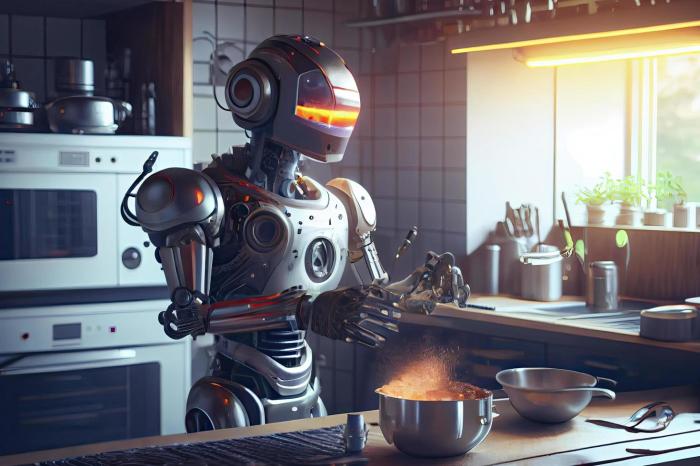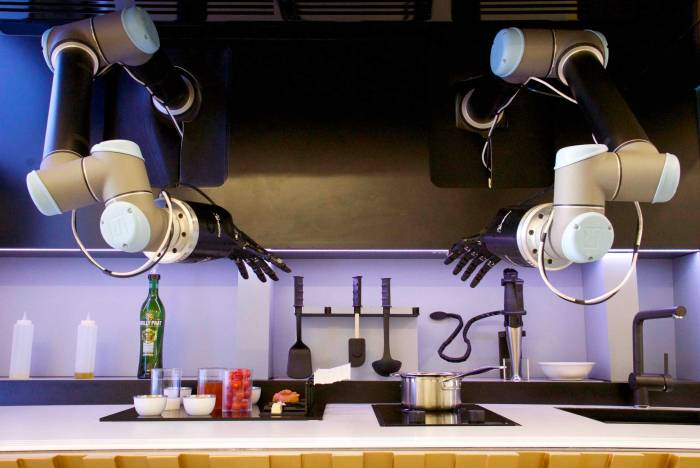The Rise of the Robotic Chef
The culinary world is witnessing a revolution, with robots taking center stage in the kitchen. Robotic chefs, once a figment of science fiction, are becoming increasingly sophisticated and accessible, promising to transform the way we cook and eat. From automated food preparation to personalized meal planning, these robotic marvels are poised to redefine the kitchen experience.
Benefits of Robotic Chefs
Robotic chefs offer a multitude of advantages, making them a compelling alternative to traditional cooking methods.
- Enhanced Efficiency: Robotic chefs can perform repetitive tasks with unparalleled speed and precision, freeing up human chefs to focus on more creative and complex aspects of cooking.
- Consistent Quality: Robotic chefs eliminate the human factor, ensuring that every dish is prepared to the same high standards, regardless of the chef’s mood or experience level.
- Reduced Food Waste: Robotic chefs can precisely measure ingredients, minimizing waste and maximizing resource utilization.
- Increased Safety: Robotic chefs can handle hot surfaces and sharp utensils with safety, reducing the risk of accidents in the kitchen.
- Accessibility to Culinary Skills: Robotic chefs democratize cooking, making it accessible to individuals with limited culinary experience.
Existing Robotic Chef Products
The market for robotic chefs is rapidly expanding, with several innovative products already available.
- Moley Robotic Kitchen: This fully automated kitchen features robotic arms that can cook a wide range of dishes, from simple meals to complex recipes. It includes a library of recipes and can even learn new ones from videos.
- ChefJet by 3D Systems: This 3D printer for food can create custom-shaped and textured dishes, allowing for unique culinary creations. It uses a variety of ingredients, including sauces, batters, and doughs, to create edible masterpieces.
- Samsung Bot Chef: This robot assistant can help with various kitchen tasks, such as chopping vegetables, stirring ingredients, and even serving meals. It can also connect to smart appliances, allowing for seamless kitchen integration.
Timeline of Key Advancements
The development of robotic chefs has been a gradual process, with significant advancements over the years.
- 1960s: The first robotic arms were developed, paving the way for automation in various industries, including food production.
- 1980s: Early prototypes of robotic chefs emerged, demonstrating the potential for automation in the kitchen.
- 2000s: Advancements in artificial intelligence and computer vision enabled robots to perform more complex tasks, including recognizing ingredients and adjusting cooking times.
- 2010s: The first commercially available robotic chefs hit the market, marking a significant milestone in the evolution of culinary technology.
- 2020s: The robotic chef market is expected to experience rapid growth, with increasing demand for automated cooking solutions.
Capabilities of Robotic Chefs
Robotic chefs are revolutionizing the culinary world with their advanced capabilities. These machines are equipped with sophisticated sensors, algorithms, and actuators, allowing them to perform various cooking tasks with precision and consistency.
Types of Dishes
Robotic chefs are capable of preparing a wide variety of dishes, ranging from simple to complex. Here are some examples:
- Basic dishes: Robotic chefs can effortlessly prepare everyday meals like pasta, stir-fries, sandwiches, and salads. They can also make simple desserts like cookies and cakes.
- Advanced dishes: Robotic chefs are also capable of creating more complex dishes like sushi, pizza, and even molecular gastronomy creations.
- Specialized cuisines: These machines can be programmed to prepare dishes from various cuisines, including Italian, French, Chinese, and Indian.
Cooking Techniques
Robotic chefs are equipped with various tools and techniques to handle different cooking methods:
- Grilling: Robotic chefs can accurately control the temperature and time of grilling, ensuring perfectly cooked steaks, burgers, and vegetables.
- Baking: They can bake bread, pastries, and cakes with precise control over temperature and humidity, ensuring consistent results.
- Frying: Robotic chefs can deep-fry or pan-fry foods with controlled oil temperature and cooking time, minimizing the risk of overcooking or burning.
- Boiling: They can accurately control water temperature and timing for boiling pasta, vegetables, and eggs.
- Steaming: Robotic chefs can use steam to cook vegetables, fish, and other foods, preserving their nutrients and flavors.
Accuracy and Consistency
One of the key advantages of robotic chefs is their ability to maintain high accuracy and consistency in their cooking.
- Precise measurements: Robotic chefs can measure ingredients with extreme precision, eliminating human error and ensuring consistent results.
- Consistent cooking times: They can precisely control cooking times, preventing overcooking or undercooking, ensuring dishes are always prepared to perfection.
- Repeatable results: Robotic chefs can replicate the same dish multiple times with identical results, making them ideal for restaurants and food production facilities.
Learning and Adaptation
Robotic chefs are capable of learning and adapting to new recipes and techniques.
- Data-driven learning: These machines can analyze vast amounts of data from recipes and cooking techniques, improving their performance over time.
- Machine learning algorithms: Robotic chefs use machine learning algorithms to learn from experience, adjusting their cooking methods based on feedback and data.
- New recipe integration: They can be easily programmed with new recipes, expanding their culinary repertoire.
The Impact of Robotic Chefs on the Culinary World
The emergence of robotic chefs is poised to revolutionize the culinary landscape, impacting not just the way we eat but also the very structure of the restaurant industry. From the dining experience to kitchen operations and food safety, the presence of robotic chefs will usher in a new era of culinary innovation.
Changes to the Dining Experience
The introduction of robotic chefs will significantly alter the dining experience, offering both benefits and challenges. Robotic chefs, programmed with precision and consistency, could potentially create a more standardized dining experience, ensuring that each dish is prepared with the same level of quality and accuracy. This could lead to a more predictable and reliable dining experience, appealing to customers who value consistency. However, it could also result in a less personalized and less engaging dining experience, as the human touch and the element of surprise that often come with traditional chefs are absent.
The Future of Robotic Chefs: Robo Chef Could Whip Up A Mean Dish
The culinary landscape is on the verge of a significant transformation, driven by the rapid advancements in robotic chef technology. From their current state of specialized tasks to the potential for complete culinary autonomy, robotic chefs are poised to revolutionize both home kitchens and professional settings.
Potential Advancements in Robotic Chef Technology, Robo chef could whip up a mean dish
The future of robotic chefs holds immense promise for enhanced capabilities and increased sophistication.
- Artificial Intelligence (AI) Integration: Robotic chefs will become more intelligent, learning from vast culinary databases and personalizing recipes based on user preferences, dietary restrictions, and even emotional states. This integration will enable them to understand complex flavor profiles, suggest substitutions, and adapt recipes based on available ingredients.
- Enhanced Dexterity and Precision: Robots will gain even greater dexterity and precision, allowing them to perform intricate tasks like delicate plating, intricate knife work, and precise temperature control with greater accuracy than humans. This will lead to consistent, high-quality dishes with minimal waste.
- Advanced Sensory Perception: Robots will be equipped with sophisticated sensors that can detect and analyze aromas, flavors, and textures, allowing them to fine-tune recipes and ensure optimal taste. This will enable them to adjust cooking times, seasoning levels, and even identify the perfect ripeness of ingredients.
- Collaborative Cooking: Robots will work alongside human chefs, taking on repetitive tasks and assisting with complex preparations. This collaboration will allow chefs to focus on creativity and innovation, while robots handle the technical aspects of cooking.
Personalization and Interactivity
The future of robotic chefs is not just about automation but also about creating a personalized and interactive culinary experience.
- Personalized Recipe Creation: Robots will learn individual preferences and dietary needs, crafting personalized recipes based on taste profiles, allergies, and dietary restrictions. They will even be able to create recipes based on specific health goals or nutritional requirements.
- Interactive Cooking Experiences: Robots will engage with users, offering cooking tips, providing real-time feedback on techniques, and even narrating the cooking process. This will enhance the culinary experience, making cooking more enjoyable and educational.
- Remote Culinary Guidance: Robots will connect to the internet, enabling remote chefs to guide and supervise cooking processes. This will allow aspiring chefs to learn from renowned culinary masters, even from the comfort of their own homes.
Robotic Chefs in Home Kitchens and Professional Settings
The impact of robotic chefs will be felt in both home kitchens and professional settings.
- Home Kitchens: Robotic chefs will become commonplace in home kitchens, simplifying meal preparation, providing personalized culinary experiences, and even reducing food waste. They will be able to prepare meals according to dietary needs, handle complex recipes, and even clean up after themselves.
- Professional Settings: Robotic chefs will revolutionize restaurants, kitchens, and food production facilities. They will handle repetitive tasks, ensure consistency in quality, and even work alongside human chefs to elevate the dining experience.
Benefits and Challenges of Widespread Robotic Chef Adoption
The widespread adoption of robotic chefs presents both opportunities and challenges.
| Benefits | Challenges |
|---|---|
| Increased efficiency and productivity | Job displacement in the culinary industry |
| Consistency and quality control | High initial investment costs |
| Reduced food waste | Potential ethical concerns about human-robot collaboration |
| Personalized and interactive culinary experiences | The need for skilled technicians to maintain and repair robots |
Robo chef could whip up a mean dish – The future of food is looking increasingly automated, and robotic chefs are at the forefront of this culinary revolution. While there are certainly ethical and societal considerations to address, the potential benefits of robotic chefs are undeniable. From increased efficiency and consistency in the kitchen to the possibility of personalized dining experiences, these machines have the power to transform the way we cook and eat. Whether they become commonplace in our homes or remain confined to professional kitchens, robotic chefs are here to stay, promising a future where food is both delicious and innovative.
Imagine a future where a robotic chef could whip up a mean dish, from perfectly seared steaks to intricate sushi rolls. While that future might seem a bit far off, we’re already seeing a glimpse of it with the launch of Windows 10 this summer. Windows 10 will be launched this summer , and with its focus on artificial intelligence, we could be one step closer to those robo-chefs cooking up a storm in our kitchens.
 Standi Techno News
Standi Techno News

